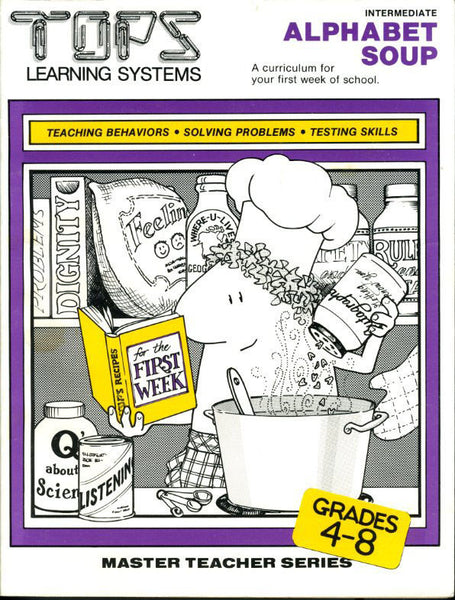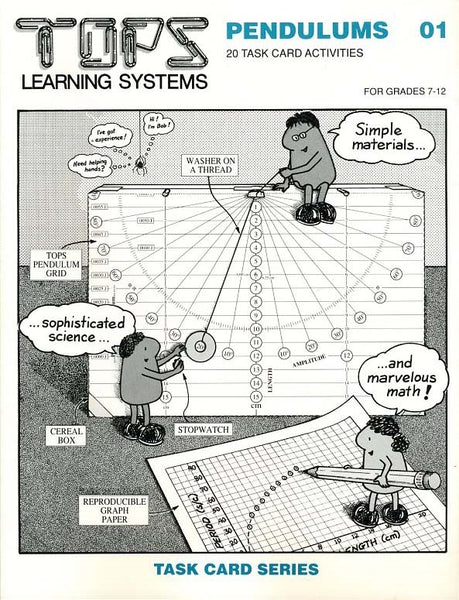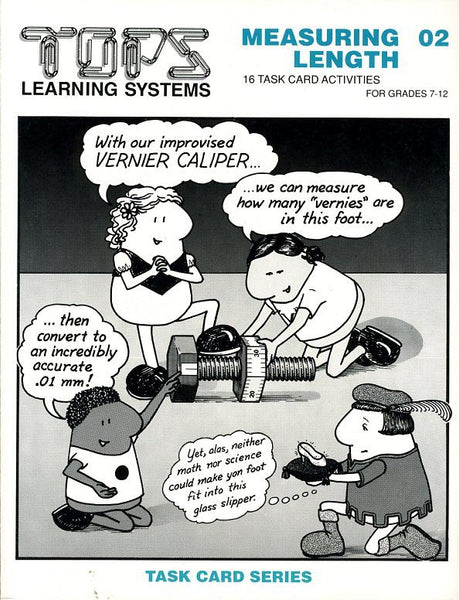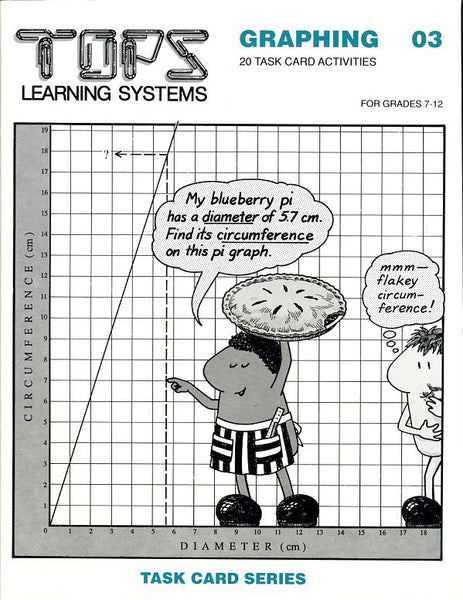#62 Intermediate Alphabet Soup (grades 4-8)
Regular price $15.00
Soft-bound, 80 page book, 31 reproducible lessons for the self-contained classroom.
A complete curriculum for your first week of school! Take your class through the alphabet -- teaching expected behaviors, solving problems, and testing skills. Do you want assignments turned in with the correct heading? Use the activity sheet "P for Paper Heading." How about managing emotions? Hand out "F for Feelings." When you want to evaluate the English skills of your new students, hand out "E is for English." Your first week in class sets the tone for the rest of the year. Make it ring with purpose and clarity. Note: check the "Master Teacher" tab on the left for a special offer on the Intermediate Master Teacher set.
More Information – click any of the tabs below to learn more about this title
A is for getting ACQUAINTED: To encourage students to get acquainted with others in their classroom community.
B is for BOOKS: To determine the reading interests of your students. To teach your school's library expectations.
C is for CONFLICT (part 1): To recognize what it means to respect dignity in others and in ourselves. To understand conflict as a collision of wants.
C is for CONFLICT (part 2): To learn how to solve conflicts peacefully.
C is for CONFLICT (part 3): To help students recall personal conflicts that were real and important to them. To understand how to channel anger in a positive direction.
D is for DECISIONS I've made: To clarify behavior expectations for your classroom.
E is for ENGLISH: To evaluate your students' capitalization, punctuation and grammar skills.
F is for FEELINGS: To encourage your students to get in touch with a broader range of emotion within themselves. To help them identify and express feelings accurately.
G is for GEOGRAPHY: To enable students to understand their special place in a very large universe.
G is for GOD (private school option): To ask God to bless the school year. To determine students' understanding of religious concepts.
H is for HANDWRITING: To determine each student's ability to form letters correctly and neatly.
I is for I - past, present and future: To understand each student as a unique individual.
J is for JELLY, JUICE and JELLO: To clarify behavior expectations for the lunchroom.
K is for KICKBALL and other games: To clarify behavior expectations on the playground.
L is for LISTENING: To appreciate that different points of view, other than you own, should be listened to carefully.
M is for MATH PROBLEMS: To assess each student's ability to complete grade-appropriate word problems successfully.
N is for NUMBERS: To assess each student's ability to complete grade-appropriate arithmetic problems successfully.
O is for OPINIONS: To become familiar with the attitudes and opinions of class members. To encourage tolerance for other points of view.
P is for PAPER HEADING: To teach students how to head their papers for all written assignments.
Q is for QUESTIONS about science: To assess how well your class understands basic science concepts. To determine which topics they like best.
R is for RULES: To diagnose each student's ability to compose clear, well-organized paragraphs. To review important school rules.
S is for SAFETY: To teach your school's fire drill policy and other important safety procedures.
T is for TIME MANAGEMENT (upper grades): To enable students to examine their schedules, and make decisions about how they spend their time.
T is for TELLING not TATTLING (lower grades): To make better judgments about the kind of information to tell adults.
U is for where U live: To review basic political geography of North America.
V is for VERY IMPORTANT PEOPLE: To introduce students to their wider school community.
W is for the WORLD: To review basic world geography.
X means you're XTRA SPECIAL: To build a sense of community and self-esteem among your students. To encourage affirming behavior and discourage put-downs.
YZ is what YOU need to ZERO in on: To review major behavior expectations presented in Alphabet Soup.
PARENT REPORT: To transfer teacher evaluation marks to a summary sheet for parent review.
Every book needs a COVER: To color a front cover, then staple it to the completed Alphabet Soup book.
B is for BOOKS: To determine the reading interests of your students. To teach your school's library expectations.
C is for CONFLICT (part 1): To recognize what it means to respect dignity in others and in ourselves. To understand conflict as a collision of wants.
C is for CONFLICT (part 2): To learn how to solve conflicts peacefully.
C is for CONFLICT (part 3): To help students recall personal conflicts that were real and important to them. To understand how to channel anger in a positive direction.
D is for DECISIONS I've made: To clarify behavior expectations for your classroom.
E is for ENGLISH: To evaluate your students' capitalization, punctuation and grammar skills.
F is for FEELINGS: To encourage your students to get in touch with a broader range of emotion within themselves. To help them identify and express feelings accurately.
G is for GEOGRAPHY: To enable students to understand their special place in a very large universe.
G is for GOD (private school option): To ask God to bless the school year. To determine students' understanding of religious concepts.
H is for HANDWRITING: To determine each student's ability to form letters correctly and neatly.
I is for I - past, present and future: To understand each student as a unique individual.
J is for JELLY, JUICE and JELLO: To clarify behavior expectations for the lunchroom.
K is for KICKBALL and other games: To clarify behavior expectations on the playground.
L is for LISTENING: To appreciate that different points of view, other than you own, should be listened to carefully.
M is for MATH PROBLEMS: To assess each student's ability to complete grade-appropriate word problems successfully.
N is for NUMBERS: To assess each student's ability to complete grade-appropriate arithmetic problems successfully.
O is for OPINIONS: To become familiar with the attitudes and opinions of class members. To encourage tolerance for other points of view.
P is for PAPER HEADING: To teach students how to head their papers for all written assignments.
Q is for QUESTIONS about science: To assess how well your class understands basic science concepts. To determine which topics they like best.
R is for RULES: To diagnose each student's ability to compose clear, well-organized paragraphs. To review important school rules.
S is for SAFETY: To teach your school's fire drill policy and other important safety procedures.
T is for TIME MANAGEMENT (upper grades): To enable students to examine their schedules, and make decisions about how they spend their time.
T is for TELLING not TATTLING (lower grades): To make better judgments about the kind of information to tell adults.
U is for where U live: To review basic political geography of North America.
V is for VERY IMPORTANT PEOPLE: To introduce students to their wider school community.
W is for the WORLD: To review basic world geography.
X means you're XTRA SPECIAL: To build a sense of community and self-esteem among your students. To encourage affirming behavior and discourage put-downs.
YZ is what YOU need to ZERO in on: To review major behavior expectations presented in Alphabet Soup.
PARENT REPORT: To transfer teacher evaluation marks to a summary sheet for parent review.
Every book needs a COVER: To color a front cover, then staple it to the completed Alphabet Soup book.






